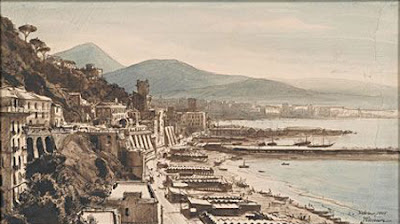After World War II ended,
Ogden Pleissner (1905-1983), who had been an Air Force captain, was commissioned by
Life Magazine to sketch some of the battlefields of Europe.
He was able to catch rides on Jeeps and airplanes, but he couldn't carry much gear. Most of the time he was working under challenging conditions. In the February, 1949 issue of
American Artist magazine, Pleissner described the painting gear that he used.
"Regarding the equipment I used in making these drawings, I will say that the fountain pen was soon discarded for some goose quills that I picked up at a farm in Normandy. I find that the line obtained by the use of the unmechanical quill or reed has, to me, greater variation and a rich quality that adapts itself completely to the wash and drybrush that is used throughout the drawings. The remaining articles are a bottle of sepia ink; two tubes of watercolor, one sepia and the other monastral [phthalo] blue; a very small watercolor palette; a medium-sized pointed sable brush and, of course, water and a block of paper."
"The general design of the drawing is lightly suggested in pencil on a piece of buff paper. This part of my procedure is quite definite; but from here on it varies. I may at times apply the washes first, thus accenting the form with the pen line, or vice versa. No doubt the orthodox method would be to draw with with the pen first and then apply the washes, but I find many interesting effects are obtained by working the ink line into the wet washes."
"My preference for using a sepia watercolor instead of the continual use of the ink is probably a very personal one; I have better control over it and find it more sympathetic to the various ways in which I handle my brush. I must add here that, if ink and watercolor are to be used, it is quite essential that they be the same color."
"It will be noted that light washes of blue are introduced in parts of the drawing, such as in the sky and here and there in the shadow planes of the landscape. This is entirely a matter of preference, but I find the introduction of a second color has great power in subtly suggesting many colors."
The best book on Pleissner is The
Art of Ogden M. Pleissner from 1984.
Previous
GJ posts on Pleissner













3 comments:
Thanks for another Ogden Pleissner post. Once again, proof that the most important piece of equipment to pack in a painting kit is skill. Here is an interesting quotation from the book, The Art of Ogden Pleissner:
"I love to look at paintings, and frequently go to museums and galleries in Europe and this country, one-man exhibitions in New York, and so forth. I am inclined to go to many of them, but I really don't learn a great deal about my work and what I am doing by looking at other people's work."
Do you own that February 1949 issue of American Artist? I'm not able to view an on-line version.
Steve, thanks for that quote. Yes, a friend gave me some old copies of American Artist, which is where I got the quote. The magazine's archives have been bought and sold by media companies, and they haven't put them online. I wish they would. People might find bound copies in their local college library. The original name of the magazine was "Art Instruction" magazine I think, founded by Watson and Guptill.
Talk about a limited pallette! I don't think it can ever be over-stated how much can be done with just a few well chosen colors.
Post a Comment